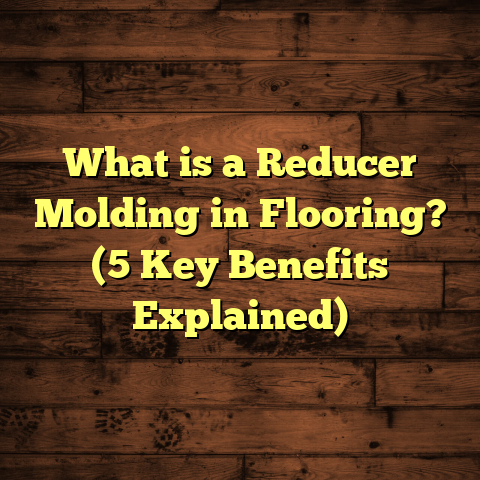What is Wood Look Ceramic Tile Flooring? (5 Must-Know Benefits)
Imagine you’ve just bought a new home or decided to give your current one a fresh makeover. You want floors that look warm and inviting like hardwood but worry about scratches, water damage, or the upkeep that natural wood demands. I’ve been there with many clients and personally as well. That’s when wood look ceramic tile flooring becomes a game-changer. It offers the rich aesthetics of wood but with the strength and practicality of ceramic tile. If you haven’t considered this option yet, stick around because I want to share everything I’ve learned—from what exactly this flooring is, to the benefits, installation insights, and real-world examples.
What is Wood Look Ceramic Tile Flooring?
Wood look ceramic tile flooring is essentially ceramic or porcelain tile designed to replicate the look and feel of wood planks. Unlike traditional ceramic tiles, which often come in square shapes and various colors, these tiles are crafted in long rectangular planks that mimic the length and width of hardwood boards.
The secret lies in advanced digital printing and glazing techniques. Manufacturers use high-resolution images of real wood grains, knots, and textures, then print these patterns onto the tile’s surface. Some tiles even have embossed textures that give a tactile wood-like feel underfoot.
Ceramic vs. Porcelain: The term “ceramic” is often used interchangeably with porcelain, but porcelain is actually a subtype of ceramic tile. Porcelain tiles are denser, less porous, and generally more durable—making them a popular choice for wood look tiles.
So, you get all the visual warmth and natural variation of wood with the hardiness of fired clay. This makes it perfect for places where hardwood might struggle—think kitchens, bathrooms, mudrooms, or homes with pets and kids.
How These Tiles Are Made
I found it fascinating when I visited a tile factory once. They start with fine clay mixed with other minerals like feldspar and quartz. This mixture is shaped into planks using extrusion or pressing methods, then dried and fired at high temperatures (about 1200°C or more). After firing, the tiles go through the digital printing phase where a high-res image of real wood is applied.
Finally comes glazing—a protective layer that seals the design and adds stain resistance. Some glazes add texture to simulate wood grain patterns, while others keep the surface smooth but matte.
The result: tiles that look convincingly like wood but are rock solid.
Why I Recommend Wood Look Ceramic Tile Flooring: 5 Benefits You Should Know
Over the years working as a flooring contractor, I’ve seen firsthand how this flooring option solves common problems while delivering style. Here’s why I keep bringing it up to homeowners:
1. Durability That Lasts Through Everything
Hardwood floors have their charm but can be vulnerable to dents, scratches from pets or furniture, and water damage. I remember a client who had beautiful oak hardwood floors but was constantly worried about scratches from their two energetic Labradors. After switching to wood look ceramic tile in their living room and hallway, they told me the floors still looked brand new after two years of heavy pet traffic.
Ceramic tiles score between 7-8 on the Mohs hardness scale; hardwood typically ranges from 3-5 depending on species. This makes ceramic much more resistant to everyday wear and tear.
Plus, porcelain tiles absorb less than 0.5% water by weight compared to hardwood’s much higher absorption rate (~6-10%), reducing risks of warping or swelling in humid conditions.
A recent industry report showed ceramic tiles last 30-50 years with proper installation—often outliving hardwood floors that might need refinishing every 10-15 years.
2. Minimal Maintenance Requirements
One of my favorite parts about recommending wood look ceramic tile is how little hassle it brings. With hardwood floors, you’re looking at regular sweeping, occasional polishing, refinishing every few years, and being careful about water spills.
With these tiles? Sweep or vacuum regularly and mop as needed—simple as that. No waxing, no sanding.
In fact, my own home has these tiles in high-use areas like the kitchen and entryway. After two years, I still use standard household cleaners without worrying about damaging the floor or dulling its finish.
Data from consumer surveys indicates homeowners spend 60-70% less time on maintenance for ceramic tile compared to hardwood annually.
3. Water Resistance for Moisture-Prone Areas
If you’ve ever dealt with water stains or swelling hardwood after a plumbing leak or spilled drinks, you know how frustrating it can be. Wood look ceramic tiles are waterproof by nature—they won’t absorb moisture or swell.
This means you can install them confidently in bathrooms, kitchens, basements, or laundry rooms without worrying about damage over time.
For example, a family I worked with in coastal Florida was concerned about humidity ruining their hardwood floors. Switching to porcelain wood look tiles eliminated those worries entirely while still giving them the warm aesthetic they wanted.
4. Realistic Wood Appearance That Impresses
I’ve heard skeptics say tile can’t match wood’s beauty. They’re often surprised when they see these newer wood look tiles in person.
The level of detail manufacturers achieve now is impressive. The color variations, knots, streaks—all recreated with precision.
One time I installed these tiles in my own living room alongside genuine hardwood in another room for comparison. Most guests couldn’t tell which was which unless they touched the floors.
This authenticity makes it easier to match existing wood décor or create a seamless flow between rooms.
5. Wide Range of Styles to Match Your Vision
Whether you want rustic barnwood vibes or sleek modern planks with gray undertones, there’s likely a wood look ceramic tile that fits your style.
These tiles come in plank sizes ranging from narrow strips (4-6 inches wide) to wider boards (up to 12 inches). Finishes vary from matte to semi-gloss.
Recently I helped a client select reclaimed pine-look porcelain for their farmhouse kitchen renovation. It added so much character without the risk of insect damage or rot that real reclaimed wood might have posed.
Let’s not forget color options—from deep espresso browns to light blonde hues—making it easier than ever to customize your space exactly as you want it.
Breaking Down Complex Flooring Choices: Why Wood Look Ceramic Tiles Stand Out
Choosing flooring can be overwhelming given all the options available today. Here’s how wood look ceramic tiles compare against other popular choices:
Hardwood Floors
Hardwood offers natural warmth but requires upkeep like refinishing every 7-10 years and careful maintenance to prevent water damage. It’s prone to scratches and dents from heavy use or pets.
Wood look ceramic tiles replicate hardwood’s look but remove many vulnerabilities like moisture issues or surface wear. You trade some softness underfoot for unmatched durability.
Laminate Flooring
Laminate imitates wood well but typically uses a fiberboard core vulnerable to moisture damage and swelling if exposed to water over time.
Ceramic tiles resist water completely and maintain their color and texture longer without fading or peeling.
Luxury Vinyl Planks (LVP)
Luxury vinyl is waterproof and softer underfoot than tile but can scratch more easily over time and may not last as long.
Tiles offer an extremely hard surface ideal for heavy traffic areas though they can feel colder compared to vinyl or wood.
Installation Tips From My Projects
Installing wood look ceramic tile requires some different steps compared to laying hardwood or vinyl flooring:
- Subfloor Prep: The subfloor must be level and clean since any imperfections can telegraph through the thin tile planks.
- Underlayment: A cement backer board or similar underlayment is necessary for stability.
- Grouting: Grout fills gaps between planks and prevents dirt build-up but requires periodic cleaning.
- Layout: Careful planning ensures staggered seams for a natural appearance.
- Cutting: Tiles need wet saws to cut precisely around corners or obstacles.
For homeowners considering DIY installation: It’s doable if you have some experience with tile work but expect several days for prep, setting, grouting, and curing.
Professional installation costs typically range from $7-$15 per square foot depending on tile quality and complexity—higher than laminate but justified by longevity and aesthetics.
Personal Story: A Kitchen Makeover Success
One project I cherish involved a couple renovating their kitchen after years of dealing with scratched hardwood floors from spills and dropped utensils. They wanted wood aesthetics without ongoing worries about damage.
We chose a medium-tone hickory-look porcelain tile with a matte finish for slip resistance. The installation took four days including prep work and grout curing.
After six months living with the new floor, they called me ecstatic—no scratches despite daily cooking chaos and kids running around. Plus, cleanup was effortless after messy dinner parties.
This experience reaffirmed how this flooring fits active family lifestyles while keeping style intact.
Data-Driven Insights Supporting Wood Look Ceramic Tile
Here are some figures from industry studies and market reports that illustrate why this flooring wins:
| Feature | Wood Look Ceramic Tile | Hardwood Floors | Laminate Flooring |
|---|---|---|---|
| Mohs Hardness Rating | 7-8 | 3-5 | 2-4 |
| Water Absorption Rate | <0.5% | 6-10% | ~12% |
| Typical Lifespan | 30-50 years | 20-30 years | 10-15 years |
| Average Maintenance Cost | $75-$125 per year | $300-$500 per year | $150-$200 per year |
| Installation Cost (per sq ft) | $7-$15 | $8-$12 | $3-$8 |
| Scratch Resistance | High | Medium | Low |
These numbers aren’t just theoretical—they reflect what I see on job sites regularly.
Addressing Common Questions I Hear About Wood Look Ceramic Tiles
Q: Do these tiles feel cold compared to wood?
A: Yes, ceramic tile tends to be cooler underfoot than wood due to its density. However, pairing it with radiant floor heating or area rugs can add warmth where needed.
Q: How slippery are these tiles?
A: Most manufacturers offer textured surfaces or matte finishes that improve traction significantly over smooth glazed tiles—ideal for kitchens or bathrooms.
Q: Can I install these over existing flooring?
A: Usually not recommended unless the current floor is very stable and level. Removing old floors ensures proper adhesion and longevity for tile installation.
Q: Are grout lines easy to keep clean?
A: Choosing darker grout colors helps hide stains better. Regular sealing of grout can also prevent dirt absorption and make cleaning easier.
Final Reflections From My Experience
Switching to wood look ceramic tile flooring has been one of the smartest moves many homeowners have made according to feedback I receive post-installation. It blends practicality with design flexibility in ways few other flooring types do.
If you’re looking for floors that resist life’s messes while giving your home that cozy wood vibe you love—these tiles deserve your consideration.
And if you want tips on picking styles or installing them right the first time—I’m here whenever you want to chat about your flooring plans!





